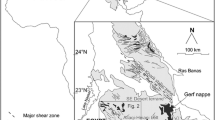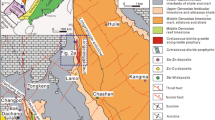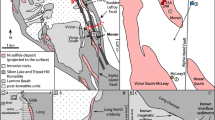Abstract
Rhenium and osmium isotopes in sulfide minerals from the Bagdad porphyry Cu–Mo deposit have been used to determine timing of mineralization and the source of osmium and, by inference, ore metals. Molybdenite, chalcopyrite and pyrite were analyzed mainly from the quartz monzonite and porphyritic quartz monzonite units, which are characterized by moderate to strong potassic alteration (secondary biotite and K-feldspar). Rhenium concentrations in molybdenite are between 330 and 642 ppm. Four Re–Os analyses of two molybdenite samples from the quartz monzonite and porphyritic quartz monzonite yield a weighted average age of 71.8±0.2 Ma (2σ). Analyses of a third sample from a molybdenite vein in Precambrian rocks, outside of the main ore zone, yield a weighted average age of 75.9±0.2 Ma (2σ), and provide evidence of two separate mineralization episodes. Chalcopyrite samples contain 6 to 12 ppt Os and 1.7 to 4.1 ppb Re; 187Os/188Os initial ratios are between 0.1 and 0.8. Pyrite samples have osmium and rhenium concentrations varying in the range 8–17 ppt and 3.9–6.8 ppb, respectively. Analyses from these pyrite samples yield an eight-point isochron with an age of 77±15 Ma (2σ) and an initial 187Os/188Os ratio of 2.1±0.8 (MSWD=0.90). The results presented here add to the growing body of work indicating that porphyry-type mineralization is produced by long-term, multiple episodes of magmatism and associated mineralization. The data also support the hypothesis that a significant part of the metals and magmas may have a crustal source, as has been suggested for other copper deposits and districts in Arizona.






Similar content being viewed by others
References
Anderson CA, Scholz EA, Strobel JD (1955) Geology and ore deposits of the Bagdad area Yapavai County Arizona. USGS Prof Pap 278
Baker A, Clayton RL (1968) Massive sulfide deposits of the Bagdad district, Yapavai County, Arizona. In: Ridge JD (ed) Ore deposits of the United States, 1933–1967. AIME 2:1311–1327
Bennet VC, DePaolo (1987) Proterozoic crustal history of the western United States as determined by neodymium isotopic mapping. Geol Soc Am Bull 99:674–685
Birck JL, RoyBarman M, Capmas F (1997) Re-Os measurements at the femtomole level in natural samples. Geostand Newslett 20:19–27
Blacet PM, Hawley JW, Schmitz CM (1994) Geology of the Bagdad mine: an outline. In: Miller M, Briscoe J (eds) Bootprints along the Cordillera Trip 17: Bagdad, Bruce/Old Dick, Copper Basin, Bradshaw Mountains. Arizona Geol Soc, Tucson, pp 17–28
Bouse RM, Ruiz J, Titley SR, Tosdal RM, Wooden JL (1999) Lead isotope compositions of Late Cretaceous and Early Tertiary rocks and sulfide minerals in Arizona: implications for the source of plutons and metals in porphyry copper deposits. Econ Geol 94:211–244
Brimhall GH (1979) Lithologic determination of mass transfer mechanisms of multiple-stage porphyry copper mineralization at Butte, Montana: vein formation by hypogene leaching and enrichment of potassium-silicate protore. Econ Geol 74:556–589
Burham CW (1979) Magmas and hydrothermal fluids. In: Barnes HL (ed) Geochemistry of hydrothermal ore deposits. Wiley, New York, pp 71–136
Cathles LM (1990) Scales and effects of fluid flow in the upper crust. Science 248:323–329
Cathles LM, Erendi AHJ, Barrie T (1997) How long can a hydrothermal system be sustained by a single intrusive event? Econ Geol 92:766–771
Chesley J (1999) Integrative geochronology of ore deposits: new insights into the duration and timing of hydrothermal circulation. In: Lambert DD, Ruiz J (eds) Application of radiogenic isotopes to ore deposit research and exploration. Rev Econ Geol 12:115–141
Chesley J, Ruiz J (1997) Preliminary Re-Os dating on molybdenite mineralization from the Bingham Canyon porphyry copper deposit, Utah. In: Thompson TB (ed) Geology and ore deposits of the Oquirrh and Wasatch Mountains, Utah. SEG Guideb Ser 29:165–169
Conway CM, Connelly TJ, Robison LC (1986) An Early Proterozoic volcanic-hydrothermal-exhalative system at Bagdad. In: Beaty B, Wilkinson PAK (eds) Frontiers in geology and ore deposits of Arizona and the Southwest. Tucson, Arizona Geol Soc Digest 16:24–34
Creaser RA, Papanastassiou DA, Wasserburg GJ (1991): Negative thermal ion mass spectrometer of Os, Re and Ir. Geochim Cosmochim Acta 55:397–401
Damon PE, Mauger RL (1966) Epierogeny-orogeny viewed from the Basin and Range Province. SME Trans 235:99–112
Frei R, Nagler T, Schonberg R, Kramers J (1998) Re-Os, Sm-Nd, U-Pb and stepwise lead leaching isotope systematics in shear zone hosted gold mineralization: genetic tracing and age constraints of crustal hydrothermal activity. Geochim Cosmochim Acta 62:1925–1936
Freydier C, Ruiz J, Chesley J, McCandless T, Munizaga F (1997) Re-Os systematics of sulfides from felsic igneous rocks: application to base metal porphyry mineralization in Chile. Geology 25:775–778
Geissman JW, Snee LW, Graaskamp GW, Carter RB, Gerahty EP (1992) Deformation and age of the Red Mountain intrusive system (Urad-Henderson molybdenum deposits), Colorado: evidence from paleomagnetic and 40Ar/39Ar data. Geol Soc Am Bull 104:1031–1047
Gustafson LB, Hunt JP (1975) The porphyry copper deposit at El Salvador, Chile. Econ Geol 70:857–912
Kendrick MA, Burgess R, Pattrick RAD, Turner G (2001) Halogen and Ar-Ar age determinations of inclusions within quartz veins from porphyry copper deposits using complementary noble gas extraction techniques. Chem Geol 117:351–370
Lang JR (1991) Isotopic and geochemical characteristics of Laramide igneous rocks in Arizona. PhD Thesis, University of Arizona
Lang JR, Titley SR (1998) Isotopic and geochemical characteristics of Laramide magmatic systems in Arizona and implications for the genesis of porphyry copper deposits. Econ Geol 93:138–170
Lowell JD, Guilbert JM (1970) Lateral and vertical alteration-mineralization zoning in porphyry ore deposits. Econ Geol 65:373–408
Luck J, Allegre C (1980) Osmium isotopes as petrogenetic tracers. Earth Planet Sci Lett 48:148–154
Ludwig KR (2001) Isoplot/Ex version 2.49. A geochronological toolkit for Microsoft Excel. Berkeley Geochronological Center Spec Publ 1a
Marsh TM, Einaudi MT, McWilliams M (1997) 40Ar/39Ar geochronology of Cu-Au and Au-Ag mineralization in the Potrerillos district, Chile. Econ Geol 92:784–806
Mathur R, Ruiz J, Munizaga F (2000a) Relationship between copper tonnage of Chilean base-metal porphyry deposits and Os isotope ratios. Geology 28:555–558
Mathur R, Ruiz J, Titley S, Gibbins S, Martogomo W (2000b) Different crustal sources for Au-rich and Au-poor ores of the Grasberg Cu-Au porphyry deposit. Earth Planet Sci Lett 183:7–14
McCandless TE, Ruiz J (1993) Rhenium-osmium evidence for regional mineralization in southwestern North America. Science 261:1262–1266
McCandless TE, Ruiz J, Campbell AR (1993) Rhenium behavior in molybdenite in hypogene and near-surface environments: implications for Re-Os geochronology. Geochim Cosmochim Acta 57:889–905
Meisel T, Walker RJ, Irving AJ, Lorand JP (2001) Osmium isotopic compositions of mantle xenoliths: a global perspective. Geochim Cosmochim Acta 65:1311–1323
Nägler TF, Frei R (1997) Plug in plug osmium distillation. Schweiz Mineral Petrogr Mitt 77:123–127
Nash JT, Cunningham CG (1974) Fluid-inlcuison studies of the porphyry copper deposit at Bagdad, Arizona. US Geol Surv J Res 2:31–34
Noble JA (1970) Metal provinces of the western United States. Geol Soc Am Bull 81:1607–1624
Norton DL (1982) Fluid and heat transport phenomena typical of copper-bearing pluton environments. In: Titley SR (ed) Advances in the geology of the porphyry copper deposits in the southwestern North America. Univ Arizona Press, pp 59–72
Ossandon G, Freraut R, Gustafson LB, Lindsay DD, Zentilli M (2001) Geology of the Chuquicamata mine: a progress report. Econ Geol 96:249–270
Padilla Garza RA, Titley SR, Pimentel F (2001) Geology of the Escondida porphyry copper deposit, Antofagasta Region, Chile. Econ Geol 96:307–324
Raith JG, Stein HJ (2000) Re-Os dating and sulfur isotope composition of molybdenite from tungsten deposits in western Namaqualand, South Africa: implications for ore genesis and the timing of metamorphism. Miner Deposita 35:741–753
Reynolds P, Ravenhurst C, Zentilli M, Lindsay D (1998) High-precision 40Ar/39Ar dating of two consecutive hydrothermal events in the Chuquicamata porphyry copper system, Chile. Chem Geol 148:45–60
Roedder E (1984) Fluid Inclusions. Mineralogical Society of America, Rev Mineral 12
Ruiz J, Mathur R (1999) Metallogenesis in continental margins: Re-Os evidence from porphyry copper deposits in Chile. In: Lambert D, Ruiz J (eds) Applications of radiogenic isotopes to ore deposit research and exploration. Rev Econ Geol 12:59–72
Ruiz J, Freydier C, McCandless T, Chesley JT, Munizaga F (1997) Re-Os systematics from base metal porphyry and manto-type mineralization in Chile. Int Geol Rev 39:317–324
Selby D, Creaser RA (2001) Re-Os geochronology and systematics in molybdenite from the Endako porphyry molybdenum deposit, British Columbia, Canada. Econ Geol 96:197–204
Shirey S, Walker R (1995) Carius tube digestion for low-blank rhenium-osmium analysis. Anal Chem 67:2136–2141
Sillitoe RH (1972) A plate tectonic model for the origin of porphyry copper deposits. Econ Geol 67:184–197
Skinner BJ (1979) The many origins of hydrothermal mineral deposits. In: Barnes HL (ed) Geochemistry of hydrothermal mineral deposits. Wiley, New York, pp 1–21
Smoliar MI, Walker RJ, Morgan JW (1996) Re-Os ages of group IIA, IIIA, IVA and IVB iron meteorites. Science 271:1099–1102
Stein HJ, Sundblad K, Markey R, Morgan JW, Motuza G (1998) Re-Os ages for Archean molybdenite and pyrite, Kuittila-Kiviso, Finland and Proterozoic molybdenite, Kabeliai, Lithuania: testing the chronometer in a metamorphic and metasomatic setting. Miner Deposita 33:329–345
Stein HJ, Morgan JW, Scherstén A (2000) Re-Os dating of low-level highly-radiogenic (LLHR) sulfides: the Harnäs gold deposit, southwest Sweden records continental scale tectonic events. Econ Geol 95:1657–1671
Suzuki K, Kagi H, Nara M, Takano B, Nozaki Y (2000) Experimental alteration of molybdenite: evaluation of the Re-Os system, infrared spectroscopic profile and polytype. Geochim Cosmochim Acta 64:223–232
Titley SR (1982) Geologic setting of porphyry copper deposits, southeastern Arizona. In: Titley SR (ed) Advances in the geology of the porphyry copper deposits in the southwestern North America. Univ Arizona Press, pp 37–58
Titley SR (1987) The crustal heritage of silver and gold ratios in Arizona ores. Geol Soc Am Bull 99:814–826
Titley SR (1991) Correspondence of ores of silver and gold with basement terranes in American southwest. Miner Deposita 26:66–71
Titley SR (2001) Crustal affinities of metallogenesis in the American Southwest. Econ Geol 96:1323–1342
Titley SR, Beane RE (1981) Porphyry copper deposits. Part I. Geologic settings, petrology, and tectonogenesis. Econ Geol 75th anniv vol:214–235
Wooden JL, DeWitt E (1991) Pb isotopic evidence for the boundary between the Early Proterozoic Mojave and Central Arizona crustal provinces in western Arizona. In: Karlstrom K, DeWitt E (eds) Proterozoic geology of ore deposits of Arizona. Arizona Geol Soc Digest 19:27–50
Zachariáš J, Pertold Z, Pudilová M, Zák K, Pertoldová J, Stein H, Markey R (2001) Geology and genesis of Variscan porphyry-style gold mineralization, Petráckova hora deposit, Bohemian Massif, Czech Republic. Miner Deposita 36:517–541
Acknowledgements
We thank Mark Baker and John Chesley for their help in the laboratory, and Robin Bouse who provided some of the samples. Victor Valencia performed microprobe analyses of samples. Analytical work was funded by the National Science Foundation grants EAR 9708361 and EAR 9628150, and instrumentation grant from the W.M. Keck Foundation. The work was also supported by the Wesley Peirce, and the David Lowell scholarships and formed part of the senior author's M.Sc. research project. We thank Phelps Dodge for allowing us access to the mine and permission to publish this information. Special thanks go to Chris Schmidtz who assisted with sulfide collecting at the Bagdad mine and provided helpful comments. This manuscript has also benefited from constructive reviews by Jason Kirk, John Chesley, Jonathan Patchett, Stephen Rowins, David Selby, and two anonymous reviewers. Editorial comments and suggestions by Richard Goldfarb are greatly appreciated.
Author information
Authors and Affiliations
Corresponding author
Additional information
Editorial handling: G. Beaudoin
Rights and permissions
About this article
Cite this article
Barra, F., Ruiz, J., Mathur, R. et al. A Re–Os study of sulfide minerals from the Bagdad porphyry Cu–Mo deposit, northern Arizona, USA. Miner Deposita 38, 585–596 (2003). https://doi.org/10.1007/s00126-002-0341-0
Received:
Accepted:
Published:
Issue Date:
DOI: https://doi.org/10.1007/s00126-002-0341-0




